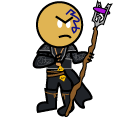Results 1 to 6 of 6
Thread: Order of Rules Application (3.5)
-
2009-12-08, 03:31 PM (ISO 8601)Troll in the Playground


- Join Date
- Mar 2009
- Location
- The Greyverse
- Gender

 Order of Rules Application (3.5)
Order of Rules Application (3.5)
We know the text from the RC: general, to specific, to exception:
"A general rule is a basic guideline, but a more specific rule takes precedence when applied to the same activity. . . . An exception is a particular kind of of specific rule that contradicts or breaks another rule (general or specific)." RC at 5.
The examples given in the RC are pretty straightforward: a monster's individual description takes precedence over general rules for monsters; a feat makes an exception to a general (or specific) rule.
It is not always so clear. When it is unclear, how do we go about determining which rule is the more specific?
There are many possible examples, and I recognize that some (a) open a CR 50 Dreadful Can o'Wurms or (b) are transparent attempts to exploit typos and similar WotC editing errors. I keep coming back to my own example, which I don't believe is either of those (whatever other failings it may have): the Diamond Mind saving roll maneuvers.
The rules for initiation of maneuvers clearly state, "You cannot use an immediate action if you are currently flat-footed." (Which I think is the basic rule, anyway, I believe.) (ToB 44.) That is clearly a "general rule," and is stated elsewhere with regard to any immediate action.
The initiation line for the three DM saving roll counters identifies them as "immediate action" initiations (which they have to be, to be effective, of course). Actually, I don't know that this entry needs to fit in the G-S-E spectrum. In any case, there is no question these are immediate actions.
The kicker: the textual description of each provides, "You can use this maneuver any time you would be required to make a _______ save," (e.g. ToB 64).
So how is the textual description of the maneuver not an exception to the general rule? (And I'll readily agree that any ambiguity could have been removed with an extra clause, either ". . . as long as you are not flat footed," or "even if you are flat footed.")
Obviously, the answer makes a big difference in the power of these maneuvers, as a save-or-_____ spell/SLA/power assault is the sort most likely to be initiated as a surprise attack (and many of these can be set up so the target is virtually guaranteed to be flat-footed).
I apologize for not letting go of this issue, but I'm still in search of a reasoned explanation.
EDIT: I should add Grynning's response and reasoning from the RAW thread:
My qualm with this is that some immediate actions clearly are performable when flatfooted. Nerveskitter springs immediately to mind, though there the exception is specifically called out (in the errata, at least; it's only implied in the original text). Originally Posted by Grynning
Originally Posted by Grynning
Last edited by Stegyre; 2009-12-08 at 03:41 PM.
-
2009-12-08, 04:18 PM (ISO 8601)Titan in the Playground


- Join Date
- Sep 2009
 Re: Order of Rules Application (3.5)
Re: Order of Rules Application (3.5)
Well, on the subject of nerveskitter, at the time there weren't any immediate or swift actions. Thus, it was just a free action. When they added the new types of actions, they added errata to give it a specific exception. Thus, it's a specific override to the general rule, and can't be used in other cases.
He fears his fate too much, and his reward is small, who will not put it to the touch, to win or lose it all.
-James Graham, 1st Marquess of Montrose
Satomi by Elagune
-
2009-12-08, 05:21 PM (ISO 8601)Troll in the Playground


- Join Date
- Mar 2009
- Location
- The Greyverse
- Gender

 Re: Order of Rules Application (3.5)
Re: Order of Rules Application (3.5)
That may have been true when Nerveskitter was first published, back in one of the Faerun books, but SC was first published in December '05, and even identifies the spell as an "immediate action."
It is a specific override of a general rule: that's the whole point of an exception.
That does not answer the question as to whether the maneuver descriptions are not also such an exception -- although a good argument could be made that unless it is explicitly called out, like the errata for Nerveskitter, WotC did not intend it as an exception.
-
2009-12-08, 07:55 PM (ISO 8601)Troll in the Playground


- Join Date
- Jul 2009
- Location
- Michigan
- Gender

 Re: Order of Rules Application (3.5)
Re: Order of Rules Application (3.5)
That's nice and all, but the errata for Spell Compendium makes note of this, calling out that, yes, Nerveskitter is an immediate action, and yes, we forgot to add a line that would allow a flat-footed character to cast it for the first round of combat.
EDIT: Bah, missed your last sentence noting the errata. My bad.Last edited by Thrice Dead Cat; 2009-12-08 at 07:56 PM.
-
2009-12-08, 08:05 PM (ISO 8601)Troll in the Playground


- Join Date
- Feb 2005
 Re: Order of Rules Application (3.5)
Re: Order of Rules Application (3.5)
Actually, it does. The answer is this very argument. Because, in general, if there is no listed exception we must assume the general rules happen, then the ability must call out that it is an exception. Certainly, Nerveskitter gives precedence for this very course of action, and is currently the only Immediate action that works that way that I know of.
-
2009-12-08, 10:48 PM (ISO 8601)Titan in the Playground


- Join Date
- May 2006
- Location
- Sunnydale
 Re: Order of Rules Application (3.5)
Re: Order of Rules Application (3.5)
I'm with Gralamin on this one. The Nerveskitter erratum establishes a pattern that such exceptions to the general rules for immediate actions will be explicitly stated.
In my games we've got an explicit house rule that you can cast Feather Fall when flat-footed, and that house rule is necessary. When they redefined Feather Fall in Complete Arcane they dropped the ball. So, by standard rules, if you get bull rushed off a cliff in the surprise round you'd better hope the drop is over 500', because that's how far you'll fall before you can cast Feather Fall.










 RSS Feeds:
RSS Feeds: 

